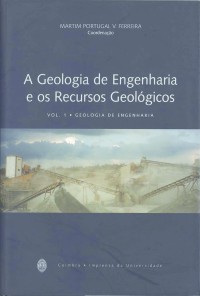Please use this identifier to cite or link to this item:
https://hdl.handle.net/10316.2/39151| Title: | Avaliação da escavabilidade de uma fundação no Grés de Silves, com base nas velocidades sísmicas | Other Titles: | Assessment the excavability of the Grés de Silves with seismic velocities | Authors: | Ferreira, Mário Quinta Figueiredo, Fernando Pedro |
Keywords: | seismic velocities;excavability;engineering geology;velocidades sísmicas;escavabilidade;geologia de engenharia | Issue Date: | 2003 | Publisher: | Imprensa da Universidade de Coimbra | Journal: | http://hdl.handle.net/10316.2/2826 | Abstract: | During the excavation for the construction of a large building in Coimbra, it was found a wide variability of the excavation resistance of the sandstones of the Grés de Silves formation. In order to quantify and to understand the variability in the excavation conditions the seismic velocity of the P waves was measured. As the outcrop surfaces that allowed the better measurement conditions were the vertical ones, resulting from the excavation for the foundation and walls of the building, it became necessary to use an unusual technique, with the geophones specific for the determination of the S waves, staked to the ground in the horizontal position, allowing to measure the P waves. The sandstone shows great variations in cement type (siliceous or ferruginous) and quantity, confering to the ground a behavior from a soil to a rock that required the use of explosives to blast the excavation. The analysis of the seismic velocities showed that only one of the tested places could be considered marginal, according with the rippability chart, while the rest of places could be excavated by mechanical equipment. Durante as escavações para implantar um grande edifício em Coimbra verificou-se grande variação da resistência ao desmonte dos arenitos da formação do Grés de Silves. Procurando quantificar e justificar as variações nas condições de escavação encontradas, procedeu-se à medição das velocidades das ondas sísmicas primárias (ondas P). Como as superfícies que melhor permitiam a caracterização dos volumes escavados eram os taludes sub-verticais resultantes das escavações, deixadas nos limites exteriores do terreno e entre os blocos das sapatas, houve necessidade de utilizar uma técnica pouco comum, recorrendo a geofones específicos para a determinação das ondas S, cravados na posição horizontal, o que permitiu registar com rigor as ondas P. No local o Grés de Silves apresenta variações muito grandes de cimentação, quer no tipo de cimento (silicioso ou ferruginoso) quer em particular na sua quantidade, conferindo ao terreno desde um comportamento muito próximo do terroso, até ao de uma rocha resistente que requer a utilização de explosivos para o seu desmonte. Os resultados das velocidades sísmicas mostram que apenas um dos locais ensaiados apresentou valores de velocidade sísmica considerada marginal, de acordo com a tabela de ripabilidades, sendo a generalidade do terreno escavável com meios mecânicos. |
URI: | https://hdl.handle.net/10316.2/39151 | ISBN: | 972-8704-14-3 978-989-26-0321-6 (PDF) |
DOI: | 10.14195/978-989-26-0321-6_15 | Rights: | open access |
| Appears in Collections: | A geologia de engenharia e os recursos geológicos. Vol. I: Geologia de Engenharia |
Files in This Item:
| File | Description | Size | Format | |
|---|---|---|---|---|
| avaliacao_da_escavabilidade.pdf | 3.05 MB | Adobe PDF |  |
Items in DSpace are protected by copyright, with all rights reserved, unless otherwise indicated.
